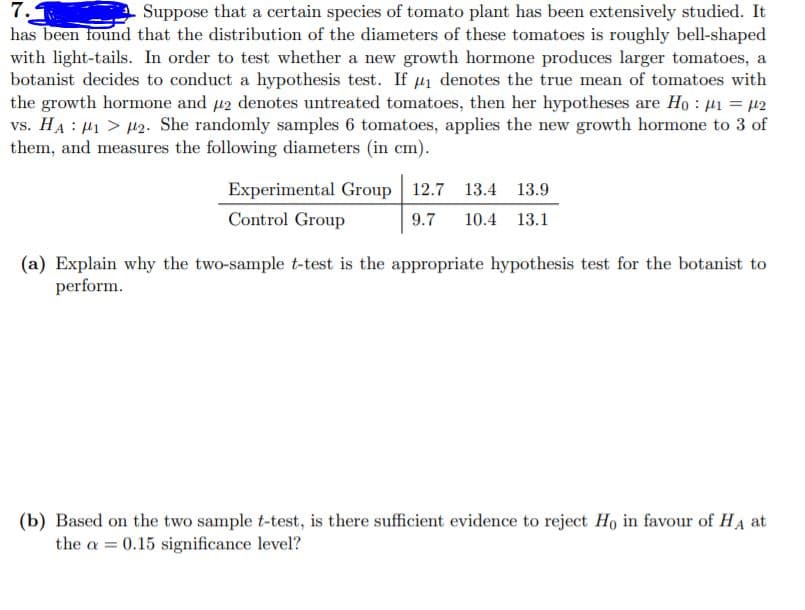7. Suppose that a certain species of tomato plant has been extensively studied. It has been found that the distribution of the diameters of these tomatoes is roughly bell-shaped with light-tails. In order to test whether a new growth hormone produces larger tomatoes, a botanist decides to conduct a hypothesis test. If µ denotes the true mean of tomatoes with the growth hormone and 42 denotes untreated tomatoes, then her hypotheses are Ho : i = 2 vs. HA : H1 > µ2. She randomly samples 6 tomatoes, applies the new growth hormone to 3 of them, and measures the following diameters (in cm).
7. Suppose that a certain species of tomato plant has been extensively studied. It has been found that the distribution of the diameters of these tomatoes is roughly bell-shaped with light-tails. In order to test whether a new growth hormone produces larger tomatoes, a botanist decides to conduct a hypothesis test. If µ denotes the true mean of tomatoes with the growth hormone and 42 denotes untreated tomatoes, then her hypotheses are Ho : i = 2 vs. HA : H1 > µ2. She randomly samples 6 tomatoes, applies the new growth hormone to 3 of them, and measures the following diameters (in cm).
MATLAB: An Introduction with Applications
6th Edition
ISBN:9781119256830
Author:Amos Gilat
Publisher:Amos Gilat
Chapter1: Starting With Matlab
Section: Chapter Questions
Problem 1P
Related questions
Topic Video
Question

Transcribed Image Text:7.
has been found that the distribution of the diameters of these tomatoes is roughly bell-shaped
with light-tails. In order to test whether a new growth hormone produces larger tomatoes, a
botanist decides to conduct a hypothesis test. If u denotes the true mean of tomatoes with
the growth hormone and u2 denotes untreated tomatoes, then her hypotheses are Ho : 41 = µ2
vs. HA : µ1 > 42. She randomly samples 6 tomatoes, applies the new growth hormone to 3 of
them, and measures the following diameters (in cm).
Suppose that a certain species of tomato plant has been extensively studied. It
Experimental Group 12.7 13.4 13.9
Control Group
9.7
10.4
13.1
(a) Explain why the two-sample t-test is the appropriate hypothesis test for the botanist to
perform.
(b) Based on the two sample t-test, is there sufficient evidence to reject Ho in favour of HA at
the a = 0.15 significance level?
Expert Solution
This question has been solved!
Explore an expertly crafted, step-by-step solution for a thorough understanding of key concepts.
Step by step
Solved in 2 steps with 1 images

Knowledge Booster
Learn more about
Need a deep-dive on the concept behind this application? Look no further. Learn more about this topic, statistics and related others by exploring similar questions and additional content below.Recommended textbooks for you

MATLAB: An Introduction with Applications
Statistics
ISBN:
9781119256830
Author:
Amos Gilat
Publisher:
John Wiley & Sons Inc

Probability and Statistics for Engineering and th…
Statistics
ISBN:
9781305251809
Author:
Jay L. Devore
Publisher:
Cengage Learning

Statistics for The Behavioral Sciences (MindTap C…
Statistics
ISBN:
9781305504912
Author:
Frederick J Gravetter, Larry B. Wallnau
Publisher:
Cengage Learning

MATLAB: An Introduction with Applications
Statistics
ISBN:
9781119256830
Author:
Amos Gilat
Publisher:
John Wiley & Sons Inc

Probability and Statistics for Engineering and th…
Statistics
ISBN:
9781305251809
Author:
Jay L. Devore
Publisher:
Cengage Learning

Statistics for The Behavioral Sciences (MindTap C…
Statistics
ISBN:
9781305504912
Author:
Frederick J Gravetter, Larry B. Wallnau
Publisher:
Cengage Learning

Elementary Statistics: Picturing the World (7th E…
Statistics
ISBN:
9780134683416
Author:
Ron Larson, Betsy Farber
Publisher:
PEARSON

The Basic Practice of Statistics
Statistics
ISBN:
9781319042578
Author:
David S. Moore, William I. Notz, Michael A. Fligner
Publisher:
W. H. Freeman

Introduction to the Practice of Statistics
Statistics
ISBN:
9781319013387
Author:
David S. Moore, George P. McCabe, Bruce A. Craig
Publisher:
W. H. Freeman